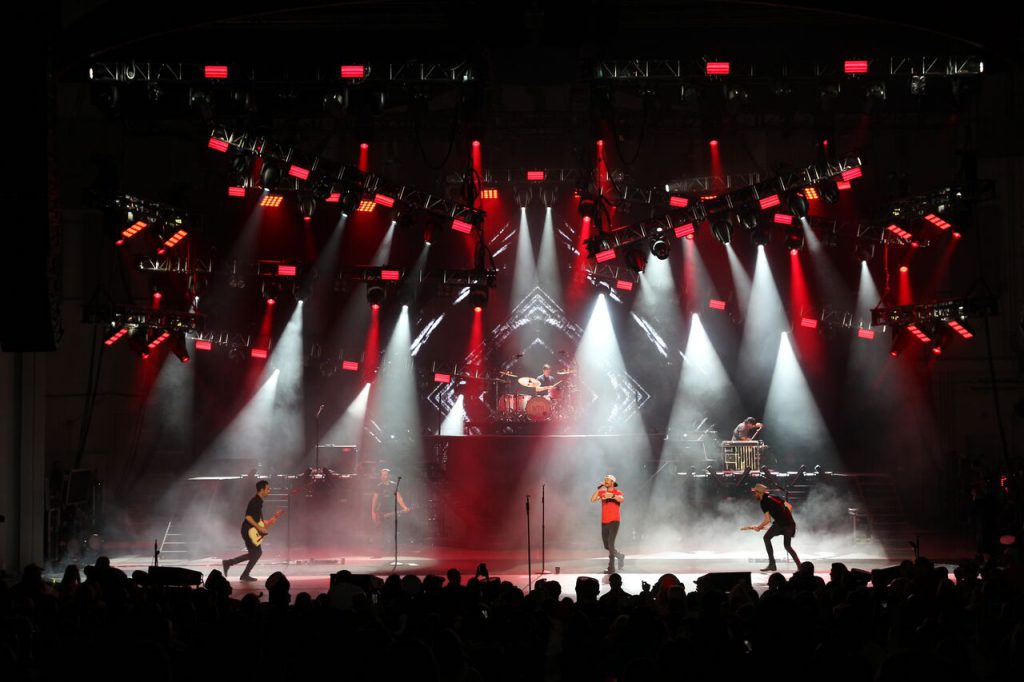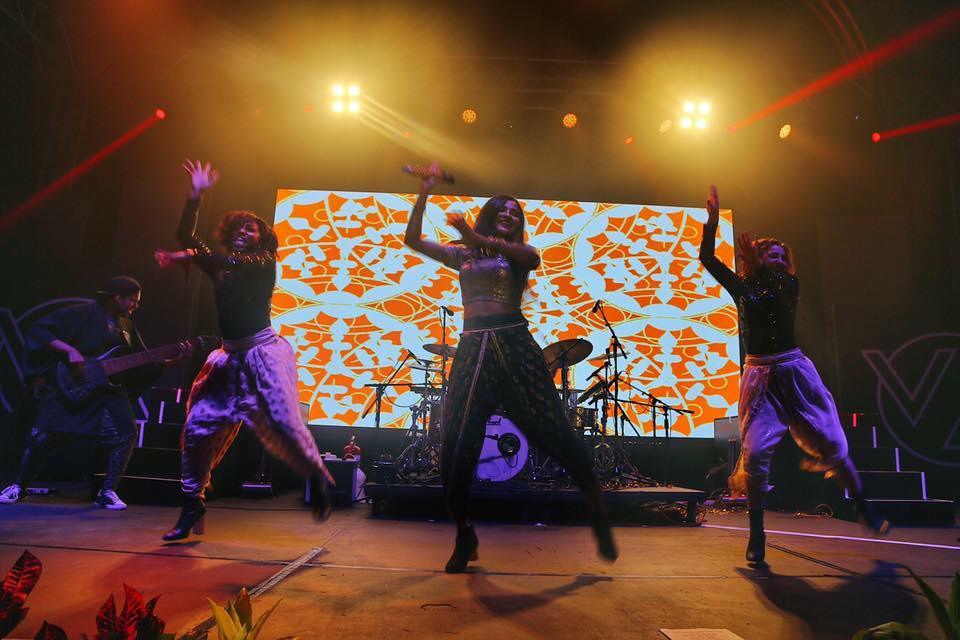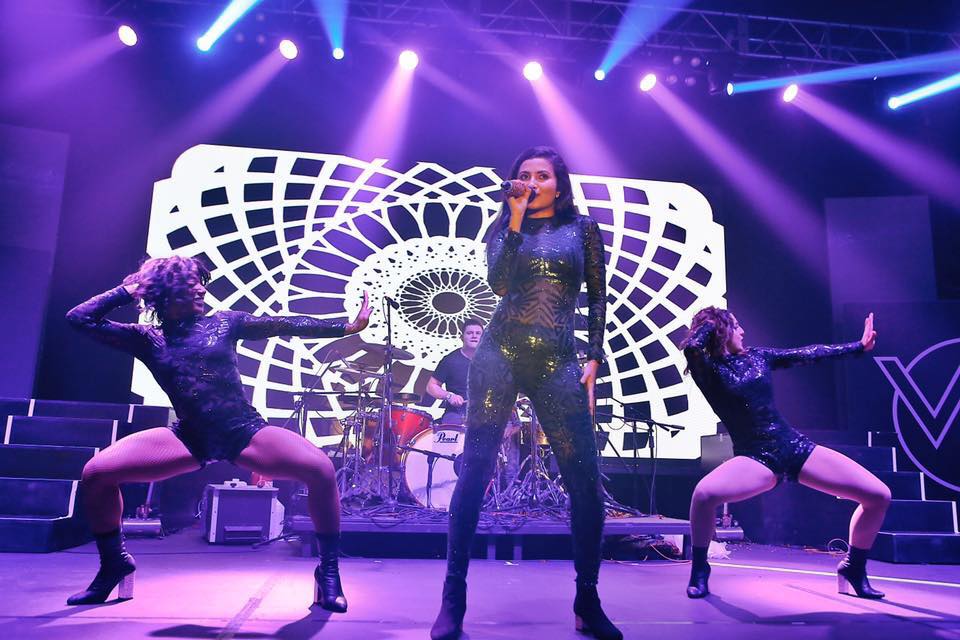Chris Reade: Light Moves
Posted on December 3, 2017
Photo: Todd Kaplan
Lights are often the last things this Las-Vegas based designer thinks of when conceptualizing looks for a tour. Admittedly that might seem strange at first, given the bright, brilliantly colored lightshows he’s created on the way to earning a CMA Award and Parnelli nomination. Still, for Reade the power of lights lies not only in their illuminance, but also in their movement through an architecture of space. It is through this carefully orchestrated passage that lighting approaches its full potential to transform and engage.
Reade has demonstrated the power of this design philosophy in his work for artists as diverse as Marc Anthony, Jennifer Lopez, Powerman 5000, Black Veil Brides, Vidya Vox and No Doubt as well as his principal current client, best-selling country artist Dierks Bentley. Often reaching high above the stage, his designs tend to feature towering truss structures. In many cases, these structures will include automated sections, the better to give light the freedom to roam over the stage and exert its beguiling power.
The co-owner with Jay Ballinger of KYVA Design LLC, Reade spoke to us from his Las Vegas office about the magic created by moving light through multi-layered space.
You’ve designed for a diverse range of prominent artists like Marc Anthony, Jennifer Lopez, No Doubt and Black Veil Brides to name a few. So, do you have to like an artist’s music to do a good job creating a lighting show for his or her concert?
“It definitely helps, yes! I think our main job is to understand the music, understand the vibe, connect to what the artist is all about, and then translate it visually.”
When you meet artists for the first time, what do you try to learn about them to establish this connection?
“I think you can learn a lot by listening. Sometimes the artists you meet and work with in real life are much different from what you see onstage. As a lighting designer, I think part of the job is to appreciate what the artists’ desires are, and understand how they want to be perceived.”
You’ve now designed ten shows for Dierks Bentley, from the days he started as an opening act. Does seeing an artist “grow up” give you a better understanding of how to design for that artist?
“I think anytime you have a longer relationship with someone, you have a better understanding of them, their likes and dislikes, as well as how they want your lighting design to contribute to their show.”
How have your designs for Dierks changed over the years?
“I think the changes in lighting instruments over the years have added a lot of possibilities to what designers can achieve visually. It’s also raised expectations on the part of the artist about what can be achieved. Of course, the designs we’ve done for Dierks have gotten bigger over the years. Bringing in Bruce Rodgers from Tribe, Inc. has expanded the scope of our designs for Dierks’ tours. Bruce and I have worked together for the last four tours, and his set and video designs inspire my lighting without question.”

Photo: Todd Kaplan
Looking at your work for Dierks and Marc Anthony as well as others, we’ve been impressed at how you build towering designs, with a lot of visual elements happening over the artist’s head. Do you think vertically when you design?
“Thank you. Of course! I am always thinking of adding visual depth to our designs, because this makes them more engaging for audiences. Vertical height has a lot to do with creating this sense of depth, so yes, most of the time you will see a vertical orientation in what we create.”
You also seem to like automated truss structures that move up and down. Can you explain what you think they add to a show?
“Automation can be fantastic, and I love it on our current Dierks Bentley tour. The movement is critical to our visual presentation of the music. Regardless of the genre of music you’re lighting, you can often get some interesting architectural looks just by moving things around a bit. Motion is at the heart of lighting so anything you can do as a designer to create more types of movement is going to make your design more alive.”
With Black Veil Brides, you did some incredible pyro effects. What advice do you have on using pyro effectively? Can pyro be over-used?
“Thank you. I can’t take credit for the pyro on that tour though! I don’t know if it would be called advice, but as with everything visual, pyro needs to have a reason for being there in your design. Pyro for the sake of pyro is silly in my opinion. I guess the concept also goes for lighting instruments. Just because a light can do something cool, it doesn’t automatically fit into your design concept, and it certainly doesn’t mean that you HAVE to use it.”
You do a lot of great collaborations with set designers like Bruce Rogers, who you mentioned earlier. What is the key to a successful collaborative relationship?
“It takes ideas to collaborate, so I’d say listening is the key. Listening is circular. It’s not a competition between people or their ideas, it’s a competition as a group with all the ideas that may look ordinary on their own so you can collaborate and come up with something creative, unique and visually stunning. We are all in this together – that’s what makes it fun.”
Speaking of being in this together, who were the people who helped you and influenced your career?
“Influence comes in many forms! Artists, architecture, other designers, music, film, etc. I am consistently impressed with Roy Bennett’s designs. I learned a lot from listening to Perry Farrell about taking chances, as well as voicing ideas even if they’re not so great to stimulate getting to the great ones. I think everyone can influence you in some way, you just have to be open to hear them out.”
What do you regard as the highlights of your career?
“I’d say having a career in this business is a pretty big highlight in and of itself! There are so many things that standout, but recently I’d say this current Dierks Bentley design with its two-year tour is a big one. Dierks is fantastic, and I’m so proud to work with him. Getting nominated for the Parnelli lighting designer of the year last year blew my mind. Winning the CMA lighting director of the year award was amazing. Working with Bruce Rodgers has been such a creative inspiration. There are so many things to be thankful for, I can’t possibly list them all.”

What do you design in?
“I use Vectorworks and Cast Wysiwyg. Sometimes that moves along through Cinema 4d.”
Can you walk us through your design process? Is there a certain design element like truss structures of video walls that you start with first?
“It depends on the project, really. The first step for me personally is always the music and the vibe. Then I consider some practical things like the venue size and the number of trucks being used on the tour. It makes no sense to design a gigantic production that takes 20 semis for a tour that is playing theatres and travels with two semis. An always-important aspect is talking ideas over with the artist. It’s also important to talk ideas with the other designers, if it’s a collaborative project. With our recent tour for Dierks, we start with the set and video elements, and then added the structures that will hold lighting fixtures to that to get a look at the overall structure. The actual lighting fixtures are usually done later depending on what the design requires.”
Looking back on your career, which design in your portfolio surprised you most? In other words, is there a design that turned out to work much better than you anticipated?
“I wouldn’t say I was ever really surprised by one of our designs. The designs are pretty well planned out and visualized, so there aren’t surprises! That being said, real life is different than visualization of course, and there are surprises here and there. Mostly, I have been surprised during programming though. I have made mistakes during programming that turned out to result in some really cool looks. Of course, when that happens, I have to go back and figure out how to repeat the ‘mistake’ again!”
What are your thoughts on LED video walls vs. projection videos?
“I love them both, actually. Each has its place and its own feel. Both can actually be used in creative ways on the same production.”
You still run the boards for some of your shows. Can you talk about that?
“Absolutely! I love programming, and I love running the show. I don’t run every show I’ve had the pleasure of being a part of, but I do enjoy it. There’s just something about the feeling of running a show that can’t be replicated. The crowd, that roar!”
If you had to describe your design philosophy in three words, what would they be?
“Creative, unique, powerful!”
Your designs are always intense without being distractive. How do you achieve that balance?
“Thank you, because I think that’s one of the best things you can say about a designer’s work. It’s a huge compliment, since it represents the essence of design. In my opinion, design is all about contributing to the vibe, and not overusing your lights.”
How would you like to be remembered as a lighting designer?
“I’d like to be remembered as a kind human being and a great dad! That is what’s most important to me.”
